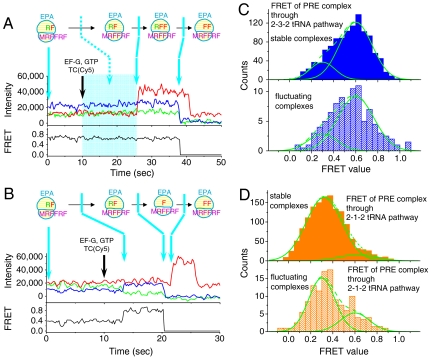Fig. 3.
Two representative single molecule translation traces initiated from preformed PRE-II2 complexes with mRNA fMRFFRFYRF (A and B) recorded at 100 ms integration time per frame with ALEX between 532 nm and 640 nm lasers. POST-II2 complexes translocated from the classical PRE state (A; high FRET before EF-G·GTP injection) and from the hybrid PRE state (B, low FRET before EF-G·GTP injection) go through 2-3-2 (A) and 2-1-2 pathways (B), respectively. Translocation, tRNA association and dissociation, indicated by changes of Cy3 and Cy5 fluorescence intensities, are marked by arrows. In A, the exact time following EF-G·GTP and TC addition at which the classical PRE-II2 complex translocates to POST-II2 complex (period marked by a cyan block) is not clear because these states have similar FRET values (classical PRE, 0.6; hybrid PRE, 0.3; POST, 0.55), so that transition is indicated by a dashed arrow. The traces were smoothed by applying a three-frame moving average. Experimental conditions as in Fig. 1. (C and D) FRET distributions of PRE-II2 states of the ribosomes that ultimately went through either the 2-3-2-tRNA pathway or the 2-1-2-tRNA pathway, respectively. Assignments of stable and fluctuating complexes were based on the transition between classical and hybrid PRE states before EF-G·GTP injection. For the fluctuating complexes, FRET values from the last second before EF-G·GTP injection were used. The solid fitted lines are Gaussian distributions and the dashed lines are the sums of two Gaussian components. The component with high FRET efficiency (0.6) is assigned as the classical state and the component with lower FRET (0.3) is assigned to the hybrid state (17, 30).

